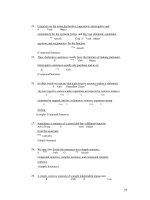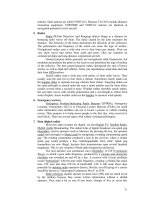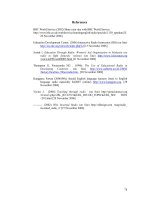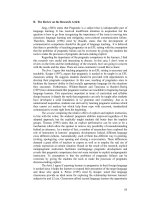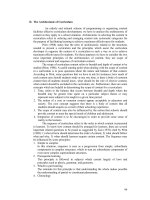Approaches to Teaching and Learning
Bạn đang xem bản rút gọn của tài liệu. Xem và tải ngay bản đầy đủ của tài liệu tại đây (720.72 KB, 111 trang )
Approaches to
Teaching & Learning
2007
INTO Consultative
Conference on Education
Irish National Teachers’ Organization
35 Parnell Square
Dublin 1
Cumann Múinteoirí Éireann
35 Cearnóg Pharnell
Baile Atha Cliath 1
Telephone: 01 804 7700
Fax: 01 872 2462
Email:
Web:
Guthán: 01 804 7700
Fax: 01 872 2462
Ríomhphost:
Gréasán:
General Secretary: John Carr
Árd Rúnaí: John Carr
TABLE OF CONTENTS
FOREWORD
Part One
Background Document
INTRODUCTION
7
APPROACHES TO TEACHING AND LEARNING IN THE REVISED CURRICULUM
11
METHODOLOGIES IN THE PRIMARY SCHOOL CURRICULUM
17
PLAY AS AN APPROACH TO TEACHING AND LEARNING IN PRIMARY EDUCATION
IN IRELAND
23
ICT AS A TOOL FOR TEACHING
29
COLLABORATION AND CO-OPERATIVE TEACHING
39
TEACHERS’ EXPERIENCES OF METHODOLOGIES AND APPROACHES
47
REFERENCES
69
Part Two
Proceedings of Conference
PRESENTATIONS
Francis Roche and Rosena Jordan, Education Committee
Paul Conway, UCC
77
87
COLLATION OF DISCUSSION GROUP REPORTS
97
–3–
Foreword
These proceedings of the Consultative Conference on Education were published in
CD format. The decision to publish on CD for the first time reflects our belief in the
potential of technology in education. The CD format allows readers to access linked
resources and websites mentioned in the report. In addition, it allows all three topics
discussed at the Consultative Conference of 2007 to be published in one volume.
Additional copies were published in printed format for the INTO library and archive.
Since the 1970s the INTO has published reports on aspects of the curriculum in the
primary school. This work was influential in shaping the Primary School Curriculum
of 1999. In this volume, we consider approaches to teaching and methodologies across
the curriculum, Physical Education and School Governance.
The Primary School Curriculum states that the process of learning is as important as
the content. It is timely, therefore - now that the curriculum implementation phase of
the PCSP has been completed - to consider how teachers are engaging with the variety of methodologies and approaches to teaching advocated in the curriculum.
According to reports on curriculum implementation (DES and NCCA), regarding
English, Maths and the Visual Arts and the INTO’s most recent curriculum survey
(2005), it is found that there are both positive and not so positive observations regarding our use of methodologies and approaches to teaching. There is evidence that
teachers are using guided discovery methods and ICT and they are planning and
providing for differentiation, integrating across the curriculum and bringing pupils on
educational walks within the environs of the school. Fostering higher-order thinking
is proving more challenging. The Education Committee’s most recent research, as
outlined in this report adds further to our understanding of what’s happening in our
classrooms.
There is a great emphasis today on the role of schools in promoting children’s wellbeing. Schools are encouraged to be ‘active schools’, creating an ethos and environment conducive to healthy physical activity.
PE was perceived important enough to set up a Joint Oireachtas Committee on the
subject. Its report recommended that the starting point for any future development of
PE in Ireland is a commitment to serious investment at all levels. Primary teachers
chapter
would certainly agree that this investment is long overdue, justified and necessary.
Investment in physical education makes sound financial sense in light of looming
healthcare costs from an increasingly unhealthy and inactive population. But regarding the provision of resources and facilities for PE in primary schools, we still have a
long way to go.
PE in primary schools has attracted a lot of attention in recent times, with demands for
increased physical activity coming from the National Task Force on Obesity and the
establishment of support groups such as Physical Education Action Group (PEAG)
and the Irish Primary PE Association among others. This report brings together some
reflective and challenging thoughts on PE policy in Ireland. It includes the voices of
some key players in the sphere of policy-making together with those of practitioners.
The Consultative Conference on Education in November 2007 provided an opportunity to us to commence a discussion within the Organisation of the issue of school
governance and the complex matters pertaining to school governance and patronage.
The patronage system, which has its origins in the historical evolution of the primary
school system, is facing new challenges, which practioners must engage.
I would like to thank the Education Committee for preparing the background reports
presented here and for their work in organising the highly successful consultative
conference on education. They are supported by the Education Section team in Head
Office, led ably by Deirbhile Nic Craith, Senior Official. I would also like to thank our
publications team who prepared the CD. Our guest speakers at the conference deserve
our special thanks for sharing their expertise with us on approaches to teaching and
PE. In particular, I wish to thank our keynote speakers, Paul Conway, UCC, Mary
O’Sullivan, UL and Niall Moyna, DCU. Finally, I would like to congratulate Aoife
Walsh and Ellen O’Grady, pupils in 4th class in Mary Immaculate GNS, Collooney, for
their courage in addressing a conference attended by over 300 teachers. They made us
proud as primary teachers.
I hope that this report will contribute to the growing research on aspects of primary
education in Ireland. The INTO will continue to ensure that the voice of teachers
remains central in policy-making in education through our involvement in the preparation of reports and the organisation of consultative conferences for our members.
John Carr, MA (Ed)
General Secretary
–5–
Approaches toTeaching and Learning
October 2008
ACKNOWLEDGEMENTS
Education Committee
Cathaoirleach
Mary Cawley,
Milo Walsh
Leaschathaoirleach
Charles Glenn
Patrick Dorrian
District II
Michael Weed
District I
District
III
Rosena Jordan
District
V
Siobhán Lynskey
District VI
Róisín Nic Thighearnáin District VII
Francis Roche
District
VIII
Nuala Uí Dhrisceoil
Aidan Gaughran
Ger Stack
Gerry O’Sullivan
Dympna Mulkerrins
Pat Scanlan
Alice O’Connell
Education Team
Office
District IX
District XI
District XII
District XIII
District XIV
District XV
District XVI
Claire Garvey
Ann McConnell
Publications Team
Lori Kealy
Sarah Brady
Administrative
Clerical Officer
Official
Clerical
Officer
Niamh Corduff
Guest Speakers
Clerical Officer
Paul Conway
University College Cork
Mary O’Sullivan University of Limerick
Niall Moyna
Dublin
City
University
–6–
chapter
Michael Queally Primary
Curriculum
Sean Gallagher Primary
Curriculum
Support Programme
Support Programme
Aoife Walsh
Mary
Ellen O’Grady
Mary
Immaculate Girls National School
Immaculate Girls National School
Proofreading
Ted Motherway
Editing and Collating
Official
Deirbhile Nic Craith
–7–
Senior
Approaches toTeaching and Learning
–8–
chapter
–9–
Approaches toTeaching and Learning
Part One
Approaches toTeaching
and Learning
–10–
chapter
–11–
1
Background Document
INTRODUCTION
he Primary School Curriculum is designed to nurture the child in all dimensions of his or her
life – spiritual, moral, cognitive, emotional, imaginative, aesthetic, social and physical (DES
1999, Primary School Curriculum, Introduction p.6). The curriculum’s vision of education is
expressed in the form of three general aims:
1. to enable the child to live as a child and to realise his or her potential as a unique
individual;
2. to enable the child to develop as a social being through living and co-operating
with others and so contribute to the good of society;
3. to prepare the child for further education and lifelong learning.
T
Learning for the child takes place in many ways and the curriculum accords equal
importance to what a child learns and the process by which he or she learns it. The
curriculum recognises that the child should be an active agent in his or her own learning and that the child’s existing knowledge and environmental experience should be
the starting point for new knowledge. The school ethos, which includes the teacher
and his or her relationship with the child, is viewed as being of paramount importance
in the learning process and “it is the quality of teaching more than anything else that
determines the success of the child’s learning and development in school” (DES 1999,
Primary School Curriculum, Introduction p.20). When children are accorded a positive
school experience which includes development of their literacy, numeracy and
communication skills, this in turn enhances their self-esteem and confidence and their
motivation to learn is increased.
The pedagogic principles of the Revised Curriculum which characterise the above
learning processes are as follows:
● the child’s sense of wonder and natural curiosity is a primary motivating factor in
learning;
● the child is an active agent in his or her learning;
● learning is developmental in nature;
–12–
chapter
●
●
●
●
●
●
●
●
●
●
●
●
the child’s existing knowledge and experience form the base for learning;
the child’s immediate environment provides the context for learning;
learning should involve guided activity and discovery methods;
language is central in the learning process;
the child should perceive the aesthetic dimension in learning;
social and emotional dimensions are important factors in learning;
learning is most effective when it is integrated;
skills that facilitate the transfer of learning should be fostered;
higher-order thinking and problem-solving skills should be fostered;
collaborative learning should feature in the learning process;
the range of individual difference should be taken into account in the learning
process;
assessment is an integral part of teaching and learning.
The Revised Curriculum is also clear that approaches to teaching can and must be
varied to complement learning and take into account the differences in children, their
interests and motivation, their varied personalities and the many ways in which they
learn. It is stated in the curriculum that the teacher needs to adopt innovative
approaches to teaching and to be aware of changes and developments in educational
theory and practice.
Given the acknowledged importance of the way teachers approach their classroom
teaching, and in the context of an expanded, child-centred, integrated curriculum to
be delivered in increasingly diverse classrooms, the Education Committee of the
INTO felt that it was timely to look at some of the current thinking in relation to
approaches to teaching.
This background document looks firstly at some of the reasons that so many different approaches to teaching exist, with a focus on the theory of multiple intelligences.
The document then outlines the central methodologies proposed in the Revised
Curriculum. Two particular approaches to teaching are described in more detail as
they are areas which provide particular challenges to teachers – Play as an approach
to teaching and ICT as an approach to teaching. Co-operative teaching is also
considered as some form of co-operative teaching is becoming more prevalent with an
increasing number of learning support and resource teachers working with class
teachers in classrooms.
The final section presents the findings of a number of focus group discussions, facilitated by a number of members of the INTO Education Committee on the theme of
teaching methodologies. Holding focus group discussions was seen by the Committee
as the most immediate and effective way of gaining an insight into the type of teaching approaches favoured by practising teachers, the factors influencing their choice of
teaching approaches, and the barriers to adapting current practice. In total, six focus
–13–
Background Document
groups were held with a total of 49 teachers participating. The sessions were recorded
and transcribed, with all identifying material omitted.
–14–
chapter
–15–
Approaches toTeaching and Learning
2
Approaches toTeaching and
Learning in the Revised
Curriculum
INTRODUCTION
eachers decide on an approach to their teaching depending on the context in
which they are teaching, which includes the nature of the pupils and the circumstance pertaining at a particular time, such as time of day, or the season, aims of the
lesson or previous experience of the class. Particular contexts may also demand particular pedagogic approaches.
T
The teacher
Teaching styles can include leading and demonstrating from the front of the class, or
adopting a more pupil-centred approach where the teacher shapes the framework
within which the pupils work and then encourages them to make their decisions
under guidance. Whether a teacher considers her/himself as part of the group where
whole-group decision making is encouraged; prefers to be fully in charge and tell
pupils what to do; or ‘goes with the flow’ letting each lesson evolve in its own way, is
all part of teaching style.
In addition, the teacher’s mood and energy levels can be factors that may alter
significantly the suitability and efficiency of any particular style. Effective teachers are
enthusiastic, flexible and well-organised. They teach children how to learn, have clarity of purpose and of explanation and good subject knowledge. They also have high
expectations and a sense of fun and humour. A good work life balance will help maintain energy levels, and will assist the teacher in remaining focused, maintaining a sense
of humour and retaining high expectations.
–16–
chapter
The pupils
Teaching and learning styles can be influenced by pupils’ age; their perspectives both
as individuals and as a group; gender and ethnic balance; the make up of the group –
ie, whether they are streamed or of mixed ability. Research indicates that mixed ability
teaching tends to be more effective for middle and lower ability pupils (Devine 2000,
Lynch 1989). The challenge is to ensure sufficient differentiation, particularly for more
able pupils. It is argued that streaming can sometimes be more effective for the most
able. However, there may be a tendency to abandon a variety of teaching and learning
styles with high-ability groups. There may also be insufficient differentiation within
groups and a lack of movement between groups, thus labelling many pupils as less
able.
A direct approach to teaching aims to acquire new knowledge and skills through a
structured sequence, often beginning with modelling, demonstration or illustration
by the teacher. Lessons typically proceed to individual or group work and often end
with whole class review. An inductive approach aims to develop a concept or process
through a structured set of directed steps, where pupils collect and sift information,
then examine data and construct categories and generate and test hypotheses. An
exploratory approach to teaching and learning aims to practise and refine understanding and skills, through pupils testing predictions or hypotheses and deciding
what information to collect, and then collecting and analysing it.
The extent to which pupils retain what they learn depends on the approach taken to
their learning. The percentage of learning retained through various approaches is as
follows:
LEARNING THEORY: RETENTION 1
5% lecture.
10% reading.
15% visual arts.
30% demonstrations.
50% small group work.
75% experimental work.
90% peer tutoring.
It is clear that the more collaborative methods of teaching are the most effective.
Pupils also need to develop personal and group skills so that they may cope with the
social context for learning, and in order to retain knowledge most effectively.
Vygotsky’s “zone of proximal development” underpins many approaches to teaching
and learning in the primary school curriculum – those tasks too difficult for the child
1
NTL
Institute.
“Retention
Rates
from
Different
/>
–17–
Ways
of
Learning”
(2000).
Approaches toTeaching and Learning in the Revised Curriculum
to solve alone can be accomplished with the help of adults/peers, through instruction,
discussion and encouragement while the child internalises the ‘how to do’ bit of the
task as part of his/her inner speech for future reference. Hannan (1996), an independent expert in how boys and girls learn, develops this idea further, and recommends a
“third/third/third” approach to proximal development, with pupils spending a third
of proximal learning time in friendship pairings/groupings, a third in single gender
non-friendship pairings and a third in mixed gender pairings, so that within one half
term everyone works with everyone else.
There are many individual learning styles, with most individuals being dominant in
one particular style. These styles are often referred to as follows:
● Visual/Spatial.
● Auditory.
● Kinaesthetic.
Visual learners prefer to see information, auditory learners like to hear information
and kinaesthetic learners learn best when physically involved (touching, doing, feeling) with their learning. Kinaesthetic learners are likely to benefit the most from active
learning although others, particularly auditory learners will benefit too. Special needs
students, such as those with dyslexia also gain a lot from active learning. Learning
styles influence how both teachers and pupils approach the curriculum in schools.
Multiple Intelligences (MI)
Traditionally schools have emphasised the development of logical intelligence and
linguistic intelligence. Multiple Intelligences is a psychological and educational theory
developed by psychologist Howard Gardner which suggests that an array of different
kinds of intelligence exists in human beings. Gardner suggests that each individual
manifests varying levels of these different intelligences and thus each person has a
unique ‘cognitive profile’.
Gardner’s theory argues that students are better served by a broader vision of
education where teachers use different methodologies, approaches and activities to
cater for all students, not just those who excel at linguistic and logical intelligence. The
revised primary curriculum emphasises the value of directed discovery learning and
an experiential approach, which are in line with MI approach.
The theory was first published in 1983 in Gardner’s work Frames of Mind: The theory
of Multiple Intelligences. In this work he defined the first seven intelligences. He added
the last two in Intelligence Reframed (1999). The nine intelligences identified by Gardner
are as follows:
Linguistic Intelligence enables individuals to communicate and make sense of the
world through language. People with heightened linguistic intelligence use words to
–18–
chapter
understand and interpret the world around them, and use words easily to communicate. They can articulate concepts that others may understand but may not have the
ability to put into words. Poets, journalists writers and orators have a heightened
linguist intelligence.
Logical-Mathematical Intelligence enables individuals to understand abstract
relations. These are concepts that do not exist in the real world but have to be imagined and documented by the brain. Scientists, mathematicians and philosophers all
rely on this intelligence. People with this ability are good at solving practical problems
because they can imagine different solutions and test them in their brain or on paper
without having to find concrete examples in real life. Mathematics is the best example.
Spatial Intelligence makes it possible for people to perceive visual or spatial information, to transform this information, and to recreate visual images from memory.
Many people find it easier to express themselves in images rather than in words. Well
developed spatial capacities are needed for the work of architects, sculptors, engineers, film-makers and designers.
Bodily/Kinesthetic Intelligence allows people to use all or part of the body to
create products, solve problems or express themselves. Athletes, surgeons, dancers,
choreographers and crafts people all use bodily/kinesthetic intelligence.
Musical Intelligence allows people to create, communicate and understand meanings made out of sound. From an early age they may lock on to melodies and rhythms
much quicker than words, numbers or images. Singers, musicians and composers all
use this intelligence.
Inter-personal Intelligence enables individuals to recognise and make distinctions
about feelings and intentions of others. According to Gardner inter-personal intelligence is seen in how one notices distinction among others, in particular, contrasts in
their moods, temperaments, motivations and intentions. Teachers, parents, politicians, psychologists and salespeople rely on inter-personal intelligence.
Intra-personal Intelligence helps individuals to distinguish among their own feelings, to build accurate mental models of themselves and to draw on these models to
make decisions about their lives. This kind of intelligence is seen in people who use
their experiences (positive and negative) to good effect, and who understand and
employ their own talents effectively.
Naturalist Intelligence allows people to distinguish among, classify, be sensitive to
and use features of the environment. Naturalist intelligence may be available to us in
the way we interact with our surroundings and the role they play in our daily lives.
Farmers, gardeners, botanists, geologists, florists and archaeologists all exhibit this
intelligence.
Existential Intelligence is the capacity to raise and reflect on philosophical questions about life death and ultimate realities.
Other intelligences have been suggested or explored by Gardner and his colleagues.
–19–
Approaches toTeaching and Learning in the Revised Curriculum
These include spiritual and moral intelligence. According to Gardner there are problems around the ‘content’ of spiritual intelligence and its privileged but unsubstantiated claims with regard to truth value. He concludes that it is best to put aside the term
spiritual intelligence due to its failure to meet a number of his criteria. Moral capacities were excluded because they are normative rather than descriptive.
The theory has its detractors in the psychology and educational theory communities. The most common criticisms argue that Gardner’s theory is based on his own
intuition rather than empirical data and that the intelligences are just other names for
talents or personality types. Despite these criticisms the theory has met with a strongly
positive response from many educators. It has been embraced by many educational
theorists and been applied to the problems of schooling. A number of schools in
North America have structured curricula according to the intelligences and many individual teachers incorporate some or all of his theory into their methodology.
–20–
chapter
–21–
Approaches toTeaching and Learning
3
Methodologies in the Primary
School Curriculum
here are six central methodologies proposed in the revised curriculum. These
are summarised as follows:
T
1. Talk and discussion
This is a central learning strategy in every curriculum area. Much learning takes place
through the interaction of language and experience. Ideas, emotions and reactions can
be explored through increasingly complex language which helps the child to clarify
and interpret experience and acquire new concepts.
2. Active learning
The child should be an active agent in his or her own learning. The curriculum is
designed to provide opportunities for active engagement in a wide range of learning
experiences. Children are encouraged to respond in a variety of ways to particular
content and teaching strategies. The teacher needs to identify particular stages of
development and to choose a sequence of activities that will be most effective in
advancing the child’s learning. This is the principle of guided activity and discovery
learning.
3. Collaborative learning
Children are stimulated by hearing the ideas and opinions of others and by reacting to
them. Collaborative work exposes children to the perceptions that others may have of
a problem or a situation. This interaction will help broaden and deepen individual children’s understanding. The act of co-operating with others facilitates the child’s social
and personal development and fosters an appreciation of the benefits of working cooperatively. The prerequisite and foundation of most instructional innovations are
–22–
chapter
co-operative learning. These innovations include:
● A thematic integrated curriculum.
● Whole language teaching.
● Critical thinking.
● Active reading.
● Process writing.
● Materials based (problem solving) maths.
● Learning communities.
● Authentic, performance-based, assessment.
4. Problem solving
Higher order thinking skills, such as summarising, analysing and making inferences
and deductions, are developed through problem solving. Tasks such as observation,
collating and evaluating evidence and identifying essential information help children
to make informed judgements. Discovery learning most notably takes place in problem solving situations where the learner draws on his/her own experience and prior
knowledge to discover the truths that are to be learned.
5. Skills through content
The ability to transfer learning is a central feature of the curriculum. Each curricular
area addresses the development of abilities and skills, which the child will be able to
apply in dealing with problems that are unfamiliar. The child’s ability to apply what
s/he has learned to a variety of situations is a good indicator of the effectiveness of
that learning.
6. Using the environment
First-hand experience that actively engages the child with the immediate environment
and with those who live in it is the most effective basis for learning. The experience
begins in the home and continues to expand, as the child grows, from the immediate
environment to the school and beyond. First hand experience of different aspects of
the curriculum outside the classroom adds to the relevance and effectiveness of children’s learning.
Some areas of the curriculum, such as English, lend themselves to many or all of
the above methods. Others, such as PE are more limited in the range of approaches
used. It is interesting that directed teaching is only mentioned in the PE and Science
subjects. Guided discovery is suggested in the following areas, PE, Science,
Geography, Music and Visual Arts. The curriculum identifies ‘linkage’ as the use of
–23–
Methodologies in the Primary School Curriculum
integration within a particular subject area, for example, when teaching ‘living things’,
integrating it with the strand on ‘environmental awareness’.
7. Integration, on the other hand refers to cross curricular connections. For the
young child, the distinctions between subjects are not relevant. What is important is
a coherent learning process that makes connections between the different subjects.
An emphasis on the interconnectedness of knowledge gives children a broader and
richer perspective and reinforces the learning process.
8. Differentiation, is the term used to describe the strategies teachers use to
enable those with diverse learning characteristics to participate in the mainstream
programme. The curriculum allows for differences in the capacity and range of individual intelligences. Differentiation is also described as adapting teaching to improve
access to learning for pupils of differing abilities. The various forms of differentiation
available to teachers include the following;
Differentiating learning objectives
● Differentiation of pace.
● Differentiation by teaching style.
● Differentiation by support: giving more help (perhaps via an SNA) to certain
pupils within the group.
● Differentiation by resource.
● Differentiation by task: setting different tasks for pupils of different ability.
● Differentiation by outcome: setting open-ended tasks, allowing pupil response at
different levels.
● Differentiation by grouping.
Teachers can also differentiate by content or context, and in their questioning techniques, by the amount of homework given or by the nature of support given. Effective
differentiation involves being sensitive to the individual characteristics of each child,
and aims to make a child feel special, valued or cared for rather than ‘different’ or less
able.
Active learning
There has been no exact definition of active learning. It has been broadly defined as
being part of a broader trend towards the use of a wide range of training and learning
styles in the classroom. Chickering and Gamson (1987) suggest that students must do
more than just listen. They must read, write, discuss or be engaged in solving prob–24–
chapter
lems. It is important that pupils are actively involved and engaging in such higher
order thinking tasks as analysis, synthesis and evaluation. Within this context, it is
proposed that strategies promoting active learning be defined as instructional activities involving students in doing things and thinking about what they are doing.
Strategies to promote active learning in the classroom, include the following:
● Discussion in class.
● Visual based instruction.
● Written exercises.
● Co-operative learning.
● Debates.
● Drama.
● Role playing and simulation.
● Peer teaching.
Active learning has many advantages as outlined below:
● It is boy (and girl) friendly.
● It aids motivation.
● It allows pupils to take control and make decisions.
● It supports the full range of intelligences and learning styles.
● It supports proximal learning.
● It develops thinking skills and creativity.
● It simulates real life.
● It differentiates by allowing pupils to access knowledge at a variety of levels.
● The skills developed allow pupils to respond flexibly to a wide range of situation.
However, there are many challenges for teachers in promoting active learning in
their classrooms. Teachers may fear the noise levels and may feel a lack of direct
control. Teachers may also fear an increase in off-task behaviour, though the opposite
is more likely to be true. They may feel a lack of direct control and involve a lot more
preparation time in the beginning. It is hard to legislate for and short-term outcomes
are less predictable and therefore it is less easy to set targets and tests. Teachers may be
brought beyond their own subject expertise. It implies a new, more equal relationship
between teacher and learner, which can make some teachers feel uncomfortable. In
addition class time is limited, large class numbers can be difficult to manage and there
is often a lack of resources.
Higher-order thinking and problem-solving
Activities which foster higher order thinking include activities such as visualisation,
empathising, role adoption, exercises in sequencing and logic, social interaction and
–25–
Methodologies in the Primary School Curriculum
activities involving adapting to changing circumstances. In addition, the capacity for
problem solving and expressing an informed opinion, elements of the above, are
nurtured in an environment where making a false hypothesis is equally as valued as
finding a solution, where interest in the process is as great as that given to the conclusion and where voices are listened to actively and with respect. Put simply, solutions to
complex problems are generally not found in one attempt; in the process the learner
must be aware that it is always okay to be wrong. Each incorrect assumption once
discounted can be viewed as a step towards the solution. Of course all higher-order
thinking and problem-solving rely on access to relevant, current and accurate information. So the first challenge for the teacher or the school organisation is to provide
access to information in a form that is appropriate to the level of cognitive ability and
development of the learner.
The definition from the 1999 curriculum refers mainly to critical and analytical
thinking. However Michael Pohl (2000) refers to three distinct types of thinking:
Critical and Analytical thinking, Creative thinking and Caring thinking. The work of
Edward de Bono on ways of thinking and his six thinking hats should also be considered. It may be as much a mistake to assume that cognition is mainly about the learning of facts and reproducing them at will as it would be to limit higher order thinking
to the analysis and evaluation of information for the purposes of finding solutions.
That could lead one to neglect important aspects of higher order thinking such as the
capacity to be creative and the capacity to respond emotively. The ability of the learner
to reflect on owned feelings and those of others and express them also belongs in the
realm of higher order thinking. The learner’s capacity to reflect on how he/she learns,
referred to as meta-cognition, belongs here also. Meta-cognition concerns knowledge
of ones own mental processes, according to Riding and Rayner (1998). Higher order
thinking is also required to engage with that dynamic generated through the sharing
of knowledge; the process that can bring about new learning through interaction with
and between learners.
Peer tutoring
Peer tutoring involves pupils working in pairs in the roles of tutor and tutee. It is a
method of engaging in one-to-one instruction and is effective from both an academic
and social point of view. Both tutor and tutee benefit from peer tutoring, it is an efficient use of teacher time and provides active learning opportunities, something highly
endorsed in the Primary Curriculum. It is an underlying principle of the curriculum
that the child should be an active agent in his or her own learning (Primary School
Curriculum 1999, Introduction p.14).
–26–




